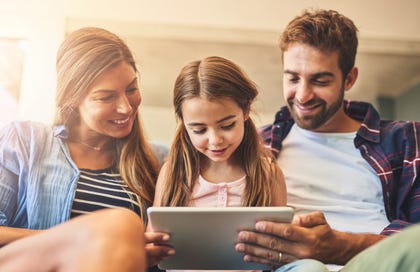It's easy to find advice on all the things your kids shouldn't be doing online. Parenting newsletters, blogs and forums offer up lots of suggestions for what not to do, which can leave you with the impression that technology is a net-negative thing for kids. But that's simply not true. Most of these alarmist headlines are focusing on a narrow use-case for technology and ignoring myriad ways that it can benefit our kids. But when we take a closer look at the issue, it's not quite so simple.
Whenever children spend time online, they're generally doing one of four things: consuming, connecting, creating or cultivating. Because YouTube is extremely popular among kids, most parents are very familiar with consumption. Watching TV or scrolling social media qualify as consumption as well—and these are usually passive activities. While consumption isn't inherently negative, the platforms we're using while we consume often have persuasive design features like autoplay, endless feeds, streaks that are meant to keep us consuming infinitely, making it difficult for users to strike a healthy balance with this activity.
By contrast, the other three activities tend to be more active, educational and fulfilling than consumption. When children use technology to connect with far-away family and friends, they strengthen their real-world relationships. Little messages and video chats can make a big difference in helping kids connect with grandparents, aunts, uncles and friends, especially when it's not possible to get together in person. When kids use tech to flex their creative muscles through coding, designing or illustrating, they're developing skills that will help them later in life. They're using their devices to actively build things, think outside the box and push the limits of their creativity. And when they use technology to cultivate new interests and passions, they learn new things and expand their horizons. The internet means that kids have the world at their fingertips—and if they have technology that helps them safely explore it, they can learn about anything that interests them.
Thinking about technology this way has helped me encourage my kids to explore positive activities. And while we all enjoy zoning out every now and then with a good show or movie, focusing on the Three C's of connection, creativity and cultivation has helped us get the most out of our time with technology.
A deeper dive
Here are a few helpful resources in case you want to really dig into today's topic:
Common Sense Media recently published a report about how tweens and teens are using tech during 2020. Their insights? Parents should worry less about the total hours that kids log on screens. One of the report's authors also told CNN that "[a]ll screen use is not equal, especially at a time when other avenues of connection and learning are shut off." Maybe they read my book?
Many tech experts had begun to explore a more nuanced idea of screen time before the pandemic, COVID-19 lockdowns certainly accelerated the conversation. Earlier this year, The New York Times published some helpful advice for finding a screen-life balance when life has shifted to screens—and it's still relevant today.
TL;DR
Too long; didn't read. It shouldn't be a full-time job to keep up on industry news, so here is a mercifully quick summary of some other notable developments:
Kids are increasingly turning to online spaces to connect with friends. Multi-player games have become a social lifeline, and a lot of kids are using platforms like Discord to chat while playing. Epic, the makers of Fortnite, have capitalized on the trend and added a new in-game video chat function powered by HouseParty. When players link their Epic and HouseParty accounts, they can enable "Fortnite Mode," create a party with up to 10 friends and share livestreams. According to writers at The Verge, "The update makes a lot of sense considering Fortnite’s steady shift from third-person shooter to full-on social space."
Lots of people around the world are facing the prospect of new restrictions on work, learning and socializing as COVID cases spike for a second time. Schools in New York City have already shuttered, and many other areas are considered an extended winter break to mitigate the spread of the virus. While online learning has received mixed reviews from parents, teachers and kids, a new technology might be the key to helping remote students feel more like they're in the classroom: telepresence robots or smart videoconferencing computers with microphones and speakers attached. According to one school administrator, when remote students log on via the robots, "[i]t feels more natural. It’s like you are sitting in the classroom and turning your head to hear who is talking.” That may seem like a small thing, but it goes a long way towards making remote students feel more included in the classroom.
And lastly
Here are a few more pieces of original writing from me and my team—just in case you're keen for more:
For an in-depth look at the Three C's—online activities that can benefit your kids—check out this Kinzoo blog post.
And for tips on how to make HouseParty as safe as possible for kids, check out these suggestions from our team.




